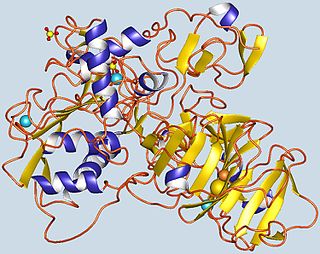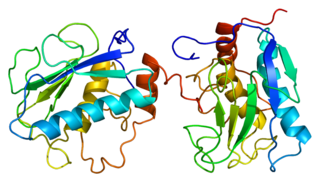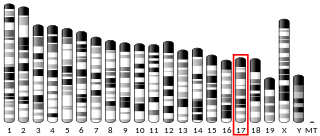Related Research Articles
Matrix metalloproteinases (MMPs), also known as matrix metallopeptidases or matrixins, are metalloproteinases that are calcium-dependent zinc-containing endopeptidases; other family members are adamalysins, serralysins, and astacins. The MMPs belong to a larger family of proteases known as the metzincin superfamily.

An osteoclast is a type of bone cell that breaks down bone tissue. This function is critical in the maintenance, repair, and remodeling of bones of the vertebral skeleton. The osteoclast disassembles and digests the composite of hydrated protein and mineral at a molecular level by secreting acid and a collagenase, a process known as bone resorption. This process also helps regulate the level of blood calcium.

Gelatinase A, also known as MMP2 is an enzyme. This enzyme catalyses the following chemical reaction
Gelatinase B is an enzyme. This enzyme catalyses the following chemical reaction
Membrane-type matrix metalloproteinase-1 is an enzyme. This enzyme catalyses the following chemical reaction
Microbial collagenase is an enzyme. This enzyme catalyses the following chemical reaction

Matrix metallopeptidase 9 (MMP-9), also known as 92 kDa type IV collagenase, 92 kDa gelatinase or gelatinase B (GELB), is a matrixin, a class of enzymes that belong to the zinc-metalloproteinases family involved in the degradation of the extracellular matrix. In humans the MMP9 gene encodes for a signal peptide, a propeptide, a catalytic domain with inserted three repeats of fibronectin type II domain followed by a C-terminal hemopexin-like domain.

72 kDa type IV collagenase also known as matrix metalloproteinase-2 (MMP-2) and gelatinase A is an enzyme that in humans is encoded by the MMP2 gene. The MMP2 gene is located on chromosome 16 at position 12.2.
Interstitial collagenase, also known as fibroblast collagenase, and matrix metalloproteinase-1(MMP-1) is an enzyme that in humans is encoded by the MMP1 gene. The gene is part of a cluster of MMP genes which localize to chromosome 11q22.3. MMP-1 was the first vertebrate collagenase both purified to homogeneity as a protein, and cloned as a cDNA. MMP-1 has an estimated molecular mass of 54 kDa.

Stromelysin-1 also known as matrix metalloproteinase-3 (MMP-3) is an enzyme that in humans is encoded by the MMP3 gene. The MMP3 gene is part of a cluster of MMP genes which localize to chromosome 11q22.3. MMP-3 has an estimated molecular weight of 54 kDa.

Matrilysin also known as matrix metalloproteinase-7 (MMP-7), pump-1 protease (PUMP-1), or uterine metalloproteinase is an enzyme in humans that is encoded by the MMP7 gene. The enzyme has also been known as matrin, putative metalloproteinase-1, matrix metalloproteinase pump 1, PUMP-1 proteinase, PUMP, metalloproteinase pump-1, putative metalloproteinase, MMP). Human MMP-7 has a molecular weight around 30 kDa.

A disintegrin and metalloproteinase with thrombospondin motifs 4 is an enzyme that in humans is encoded by the ADAMTS4 gene.

Stromelysin-2 also known as matrix metalloproteinase-10 (MMP-10) or transin-2 is an enzyme that in humans is encoded by the MMP10 gene.

Collagenase 3 is an enzyme that in humans is encoded by the MMP13 gene. It is a member of the matrix metalloproteinase (MMP) family. Like most MMPs, it is secreted as an inactive pro-form. MMP-13 has an predicted molecular weight around 54 kDa. It is activated once the pro-domain is cleaved, leaving an active enzyme composed of the catalytic domain and the hemopexin-like domain PDB: 1PEX. Although the actual mechanism has not been described, the hemopexin domain participates in collagen degradation, the catalytic domain alone being particularly inefficient in collagen degradation. During embryonic development, MMP-13 is expressed in the skeleton as required for restructuring the collagen matrix for bone mineralization. In pathological situations it is highly overexpressed; this occurs in human carcinomas, rheumatoid arthritis and osteoarthritis.

Matrix metalloproteinase-19 (MMP-19) also known as matrix metalloproteinase RASI is an enzyme that in humans is encoded by the MMP19 gene.

Matrix metalloproteinase-25 is an enzyme that in humans is encoded by the MMP25 gene.

Neutrophil collagenase, also known as matrix metalloproteinase-8 (MMP-8) or PMNL collagenase (MNL-CL), is a collagen cleaving enzyme which is present in the connective tissue of most mammals. In humans, the MMP-8 protein is encoded by the MMP8 gene. The gene is part of a cluster of MMP genes which localize to chromosome 11q22.3. Most MMP's are secreted as inactive proproteins which are activated when cleaved by extracellular proteinases. However, the enzyme encoded by this gene is stored in secondary granules within neutrophils and is activated by autolytic cleavage.

Peptidoglycan binding domains have a general peptidoglycan binding function and a common core structure consisting of a closed, three-helical bundle with a left-handed twist. It is found at the N or C terminus of a variety of enzymes involved in bacterial cell wall degradation. Examples are:
Atrolysin A is an enzyme that is one of six hemorrhagic toxins found in the venom of western diamondback rattlesnake. This endopeptidase has a length of 419 amino acid residues. The metalloproteinase disintegrin-like domain and the cysteine-rich domain of the enzyme are responsible for the enzyme's hemorrhagic effects on organisms via inhibition of platelet aggregation.
Stromelysin 2 is an enzyme. This enzyme catalyses the following chemical reaction
References
- ↑ Hasty KA, Jeffrey JJ, Hibbs MS, Welgus HG (July 1987). "The collagen substrate specificity of human neutrophil collagenase". The Journal of Biological Chemistry. 262 (21): 10048–52. PMID 3038863.
- ↑ Hasty KA, Pourmotabbed TF, Goldberg GI, Thompson JP, Spinella DG, Stevens RM, Mainardi CL (July 1990). "Human neutrophil collagenase. A distinct gene product with homology to other matrix metalloproteinases". The Journal of Biological Chemistry. 265 (20): 11421–4. PMID 2164002.
- ↑ Knäuper V, Krämer S, Reinke H, Tschesche H (April 1990). "Characterization and activation of procollagenase from human polymorphonuclear leucocytes. N-terminal sequence determination of the proenzyme and various proteolytically activated forms". European Journal of Biochemistry. 189 (2): 295–300. doi: 10.1111/j.1432-1033.1990.tb15489.x . PMID 2159879.